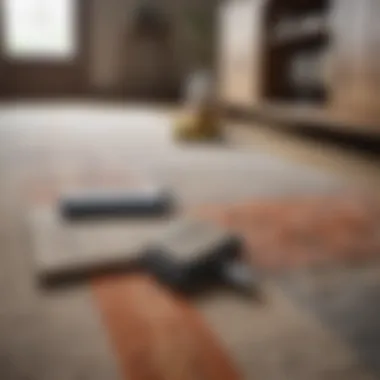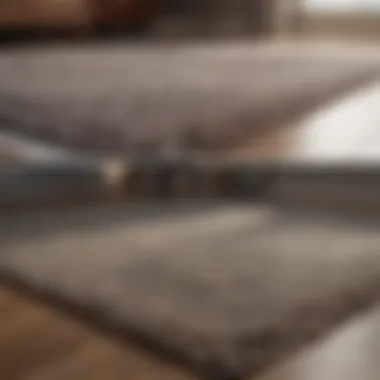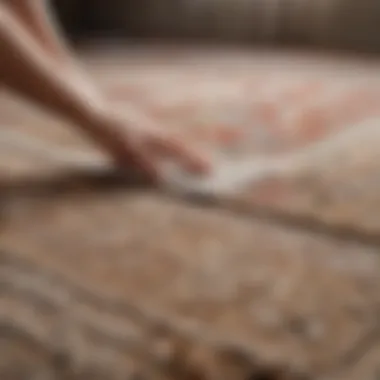Deep Cleaning an Area Rug: Techniques & Insights


Intro
Deep cleaning an area rug is more than a mere chore; it is an investment in the longevity and beauty of your home. Area rugs not only enhance the aesthetic atmosphere of any room but also serve as functional components, protecting flooring and adding warmth. Understanding how to effectively clean these textiles is crucial for preserving their quality.
Choosing the appropriate cleaning method depends largely on the material of the rug. Different fibers require different approaches. For instance, a wool rug may need a different technique compared to a synthetic one. This article aims to provide a comprehensive guide detailing the necessary tools, specific methods, and preventative measures to maintain your rug's appeal and durability.
Understanding Rug Materials
Rugs come in various materials, each presenting distinct cleaning requirements. The main types include:
- Wool: Soft and durable, wool rugs are often more expensive. They can withstand frequent cleaning but require specific products to prevent damage.
- Cotton: Generally more accessible and machine-washable. However, cotton rugs can fade over time if exposed to intense sunlight.
- Synthetic Fibers: These rugs are often resistant to staining and can be cleaned more easily. They are generally more affordable.
- Silk: Elegant and luxurious but delicate. Silk rugs demand the utmost care, as aggressive cleaning can lead to irreparable damage.
By acknowledging these differences, homeowners can select suitable cleaning techniques tailored to their rugs' specific needs.
Importance of Deep Cleaning
Deep cleaning an area rug extends beyond the surface. Accumulated dirt, allergens, and stains can worsen if not addressed correctly. Here are some key insights:
- Longevity: Regular cleaning can increase the lifespan of a rug. By removing trapped dirt and debris, fibers remain intact for a longer period.
- Aesthetic Appeal: A clean rug enhances the overall beauty of a room. Stains and dirt diminish visual appeal and may affect the entire design scheme.
- Health Benefits: Area rugs can harbor allergens and dust mites. Effective cleaning removes these particles, contributing to better indoor air quality.
"Regular maintenance is key to preserving the integrity and beauty of your area rugs."
Overall, the importance of deep cleaning an area rug cannot be overstated. This article will delve into practical methods, required tools, and additional insights, ensuring that readers are well-equipped to undertake this task effectively.
Understanding Area Rugs
Understanding area rugs is vital to fully grasp the complexities of deep cleaning them. Area rugs have significance beyond mere decoration in a home. They contribute to comfort, aesthetics, and can even impact room acoustics. Grasping their uniqueness allows for better care practices, ensuring that they last longer and look their best.
Definition and Types
Area rugs are textile floor coverings that can enhance the interior of a space. Unlike wall-to-wall carpeting, they can be moved and arranged differently. Area rugs come in various styles, shapes, and sizes.
- Traditional Rugs – These often feature intricate patterns and rich colors, typical in Persian and Oriental styles.
- Modern Rugs – Geometric or abstract designs generally define these, appealing to minimalist and contemporary tastes.
- Outdoor Rugs – Made from durable materials, suitable for patios and outdoor areas, these rugs can withstand weather conditions.
Choosing the right type of area rug can set the tone for a room. Each type serves a function while providing specific aesthetic value.
Materials Used in Area Rugs
The materials used in area rugs greatly influence their durability, comfort, and care needs.
- Wool – Soft, durable, and naturally resistant to staining and dirt. It's a popular choice, especially in high-traffic areas.
- Synthetic Fibers – Materials such as nylon, polyester, and polypropylene offer durability and are often easy to clean.
- Natural Fibers – Rugs made from jute, sisal, or cotton provide a unique texture but typically require more maintenance to avoid damage.
Understanding these materials is crucial. Different fibers respond to cleaning processes differently. Knowing what your area rug is made of helps you avoid damaging detergents or excessive moisture during cleaning.
The Importance of Deep Cleaning
Deep cleaning an area rug is a crucial task that goes beyond mere aesthetics. It plays a significant role in maintaining both the health of individuals in the space and the longevity of the rug itself. This section discusses why deep cleaning is vital, focusing on various benefits and considerations.
Health Benefits
One of the most pressing reasons for deep cleaning is the health benefit it provides. Area rugs can trap a multitude of allergens and pollutants such as dust, pet dander, and mold spores. These particulates can exacerbate respiratory issues or allergies, particularly for vulnerable populations.
- Allergen Reduction: Regular deep cleaning helps to remove allergens that accumulate over time. This creates a healthier environment, reducing allergy symptoms and respiratory problems.
- Bacteria and Germ Control: Rugs can also harbor bacteria and germs. Deep cleaning processes, particularly steam cleaning, can help eliminate these harmful microorganisms.
- Improving Indoor Air Quality: By removing trapped pollutants, deep cleaning enhances the overall air quality in the home. This is especially important in spaces where individuals spend a considerable amount of time.
Cleaning techniques like vacuuming and shampooing effectively target deep-seated dirt, contributing to a healthier living space.


Aesthetic Considerations
Aesthetics is another essential aspect of maintaining area rugs. A clean rug not only looks better but also enhances the overall appearance of the room. This has implications for the overall ambiance and value of one's interior decor.
- Vibrancy Restoration: Deep cleaning can restore the vibrancy of colors in a rug. Over time, dirt can dull the appearance, making colors look muted. By deep cleaning, one can revive the rich hues and patterns of the rug.
- Stain Management: Accidental spills happen, and stains can become permanent if not addressed promptly. Effective cleaning methods, such as spot cleaning, can remove or reduce these stains, maintaining the rug's aesthetic appeal.
- Longevity and Value: A well-maintained rug can retain its value longer. Buyers often look for quality and condition when purchasing. Deep cleaning is an investment in the rug’s lifespan and future resale value.
"Regular maintenance, including deep cleaning, not only enhances beauty but also ensures the area rug serves its purpose effectively for years to come."
Preparing for Deep Cleaning
Preparing for deep cleaning an area rug is a crucial step that can determine the effectiveness of the entire process. This specific phase involves careful considerations regarding the rug's condition, the tools and supplies needed, and the cleaning methods to be employed. Understanding this preparation phase is in itself an opportunity to prolong the life and enhance the appearance of an area rug, making it essential for any homeowner or cleaning enthusiast.
Assessing the Rug's Condition
Before any cleaning occurs, assessing the rug's condition is important. Not all rugs are made from the same materials or crafted using identical techniques, which means their needs can vary widely. Here are the key aspects to consider:
- Inspect for Damage: Look for tears, frayed edges, or other signs of wear. Damaged areas may require specific treatment or even professional assessment before proper cleaning can begin.
- Evaluate Staining: Identify any visible stains and how long they have been present. Some stains may need particular treatments to avoid damage during cleaning.
- Check for Colorfastness: Certain dyes can bleed or fade when exposed to water or cleaning agents. Testing a small inconspicuous area can provide clarity on how the rug will react to cleaning methods.
This step ensures a tailored approach to cleaning, addressing each rug's unique condition and preventing further damage.
Gathering Tools and Supplies
The next phase of preparation involves gathering the necessary tools and supplies for deep cleaning. Having the right equipment makes the process smoother and more efficient. Key items generally include:
- Vacuum Cleaner: A vacuum designed for area rugs can effectively remove dirt and loose debris.
- Soft Brush: A soft-bristled brush is vital for agitating dirt without damaging fibers.
- Cleaning Solutions: Depending on the rug material, choose appropriate cleansers, such as wool-safe shampoos or chemical-free options for synthetic fibers.
- Buckets and Towels: For handwashing methods, an ample supply of buckets and absorbent towels is necessary, aiding both the cleaning and drying process.
- Stain Remover: Specific stain removers can target particular blemishes, ensuring the best results.
Ensuring that the right tools are on hand not only enhances the effectiveness of cleaning but also prevents unnecessary delays.
Choosing the Right Cleaning Method
Once you've assessed the rug's condition and gathered your supplies, it's time to select a suitable cleaning method. The choice hinges upon factors such as the rug material, intensity of stains, and any pre-existing damage. Common methods to consider include:
- Vacuuming: Ideal for regular maintenance, it removes surface dirt and dust.
- Shampooing: Good for deeper cleansing, this method works well for both synthetic and natural fiber rugs.
- Steam Cleaning: A method that utilizes hot water vapor to sanitize and remove dirt without excessive moisture.
- Dry Cleaning: This method uses specialized chemicals to lift dirt, a suitable choice for rugs that cannot tolerate water.
Selecting the appropriate method not only ensures effective cleaning but also protects the integrity of the rug, safeguarding it for years to come.
Taking the time to prepare effectively lays a solid foundation for the deep cleaning process, allowing for a thorough and careful approach. This preparation phase is essential in realizing the true potential of your area rug's beauty and functionality.
Detailed Cleaning Techniques
Deep cleaning techniques are essential for maintaining the beauty and integrity of area rugs. These methods not only enhance appearance but also increase durability and promote a healthier living environment. Cleaning techniques vary depending on the type of rug material, dirt level, and staining. Understanding each approach ensures that rugs get the care they need without causing damage.
Vacuuming
Vacuuming may seem simple, yet it's one of the most vital steps in area rug maintenance. Regular and thorough vacuuming prevents dirt build-up and extends the life of the rug. It removes dust, debris, and allergens from the fibers. To maximize effectiveness, choose a vacuum with adjustable suction settings and a brush attachment for deeper penetration. It’s crucial to tackle both sides of the rug if possible, as dirt can settle on the underside as well.
Spot Cleaning
Spot cleaning is necessary to address specific stains or spills immediately. Each type of stain may require a different cleaning solution. For example, water-soluble stains, like soft drinks or coffee, should be treated with water and a mild detergent. On the other hand, oily stains, such as grease or ink, may require a solvent-based cleaner. Using a white cloth, gently blot the stain without rubbing, as this can spread it further. Prompt action is vital to prevent permanent damage to the rug fibers.
Shampooing
Shampooing is a more thorough approach to cleaning. It involves applying a carpet shampoo specifically designed for your rug's material. Generally, a soft brush or sponge is used to work the shampoo into the fibers. Make sure to rinse the rug thoroughly to remove all soap residue. This process can restore vibrancy to dull or dirty rugs and remove trapped odors. However, it’s important to follow the manufacturer's guidelines for frequency and method, as excessive moisture can lead to mold growth.
Steam Cleaning


Steam cleaning is an effective method for deeper cleaning, especially for synthetic and durable fibers. This technique uses heat to loosen dirt and grime. It’s advisable to use professional-grade steam cleaners, as they reach higher temperatures than regular machines. The benefits include killing germs and bacteria. However, be mindful not to over-wet the rug, as this can lead to damage. Testing a small area first is sensible to ensure compatibility with the fibers.
Dry Cleaning
Dry cleaning is a technique that involves using specialized chemicals instead of water. This method is often for delicate rugs that cannot withstand moisture well, such as silk or vintage pieces. Dry cleaning foam or powder is applied, then agitated into the fibers. After a set time, the residue is vacuumed away, leaving the rug clean and dry. It is effective, reduces water damage risks, and is often preferred for high-end area rugs.
Post-Cleaning Care
Post-cleaning care is a crucial step in maintaining the appearance and longevity of an area rug. After the deep cleaning process, paying attention to how the rug is dried, odor issues are managed, and how it is repositioned can significantly influence its condition over time. Each of these elements contributes to preserving the rug's quality and aesthetic value.
Drying Techniques
Proper drying techniques are essential after cleaning an area rug. If a rug remains damp, it could lead to mold or mildew, which can ruin both its look and smell. Here are some effective drying methods:
- Air Drying: Lay the rug flat in a well-ventilated area. If possible, place it outside on a sunny day, ensuring both sides receive good air flow. This method is gentle and preserves the integrity of the fibers.
- Hanging: Another method is to hang the rug over a railing or a sturdy chair. Ensure it hangs evenly to prevent warping. This technique allows air to circulate around the rug but can lead to uneven drying if not monitored continuously.
- Using Fans: Setting up fans around the rug can enhance air circulation. Position the fans to blow across the surface of the rug, reducing drying time significantly.
- Dehumidifiers: In humid climates, using a dehumidifier can help reduce moisture in the air, further aiding the drying process.
If drying is done correctly, odors, staining, and structural damage can be avoided.
Dealing with Odors
Odors can persist even after a thorough cleaning. To effectively manage them, consider these steps:
- Baking Soda: Sprinkle baking soda liberally over the entire surface of the rug. Let it sit for several hours or overnight if possible, then vacuum. Baking soda is excellent for absorbing and neutralizing odors.
- White Vinegar Solution: Mix equal parts water and white vinegar. Lightly spray this solution on the affected areas and let it dry. The vinegar smell will dissipate, carrying other odors away. Always test a small, inconspicuous area before applying it broadly.
- Essential Oils: Adding a few drops of essential oils to the baking soda before application can provide a pleasant fragrance without chemicals.
Efficiently managing odors will keep the rug smelling fresh and inviting, contributing to the overall ambiance of the space.
Repositioning and Maintenance
Repositioning the rug after cleaning is an important consideration. Once it is dry and free from odors, determine its best location. Moving it too soon after cleaning can disturb the fibers and lead to uneven wear. Factors to consider include:
- Traffic Flow: Place the rug in a way that respects the natural flow of foot traffic. This will minimize wear in high-traffic areas.
- Sunlight Exposure: Refrain from placing the rug in direct sunlight for prolonged periods. UV light can fade colors and weaken fibers over time.
- Regular Rotation: Depending on the rug's use and location, rotate it every few months. This can help ensure even wear and prolong its lifespan.
By following these post-cleaning care practices, individuals can maintain the integrity and beauty of their area rugs. These steps form a comprehensive guide that supports the longevity of rugs, safeguarding both their aesthetic and structural qualities.
Consequences of Inadequate Cleaning
Inadequate cleaning of area rugs can lead to serious issues that affect both the appearance and longevity of these valuable home decor items. Understanding the consequences is essential for any rug owner looking to maintain their investment. Dirty rugs not only lose their aesthetic appeal but also present health hazards that can escalate over time. Addressing these concerns is key to preserving the integrity of your rug.
Structural Damage
When rugs accumulate dirt, dust, and allergens, they can experience irreversible structural damage. This damage manifests as fraying edges, weakened fibers, and a breakdown of the rug's foundation. The longer a rug goes without proper cleaning, the more its fibers become entangled with dirt particles. Consequently, the organic materials in the fibers can degrade. This degradation often leads to shedding and may even require costly repairs or replacement. Regularly deep cleaning can prevent these issues, ensuring the rug remains in good shape.
"Ignoring maintenance not only affects the rug's look but also its lifespan."
Staining and Discoloration
Stains and discoloration are common repercussions of inadequate cleaning. From everyday spills to pet accidents, various substances can infiltrate the fibers. If not addressed immediately, these stains can become permanent fixtures on the rug's surface. Moreover, sunlight exposure can exacerbate this issue, leading to uneven fading across the rug. Such discoloration diminishes the rug’s overall beauty and can detract from the room’s aesthetic value.
The risk of stains and discoloration highlights the significance of immediate action after incidents. Regular maintenance can effectively remove surface dirt and prevent deeper stains from forming.
Key takeaways:
- Proper cleaning prevents structural damage and prolongs the rug's lifespan.
- Immediate attention to spills can minimize staining and discoloration risks.
- Routine care is essential for maintaining the rug’s beauty.
Professional Cleaning Services


When considering how to keep an area rug looking pristine, professional cleaning services emerge as a significant aspect. These services are often preferred by individuals who may lack the time, expertise, or resources to handle deep cleaning on their own. They not only save time but also provide specialized know-how and equipment that can tackle stains and odors that regular cleaning methods might not resolve. The investment in professional services can ultimately extend the life of the rug while enhancing its aesthetic appearance.
When to Seek Professional Help
There are specific instances where turning to professionals is advisable. Here are some scenarios:
- Severe Stains or Odors: If a rug has persistent stains or an unpleasant smell, a professional's advanced techniques can address these effectively. Typical cleaning methods may not be sufficient in such cases.
- Delicate Fabrics: Rugs made from delicate materials like silk or antique fibers require specialized care that amateurs might not provide. In such cases, seeking help ensures the rug is handled with the utmost caution.
- Full Restoration Needed: Sometimes, rugs may need more than just cleaning. Issues such as fraying edges, fading colors, or damage from pets can necessitate a restoration service.
- Allergies or Health Concerns: If someone in the household has allergies, regular deep cleaning can help but might not be enough. A professional cleaning can eliminate allergens completely.
Evaluating Service Providers
Selecting the right cleaning service is crucial. Be sure to consider the following factors:
- Experience and Expertise: Look for providers with a strong history of handling area rugs and proper certifications in cleaning techniques.
- Reputation and Reviews: Customer feedback can provide insight into the quality of service offered. Check platforms like Yelp, Google reviews, or even Reddit discussions for firsthand experiences.
- Services Offered: Not all companies provide the same services. Ensure that the company covers what is needed specifically for your rug type.
- Pricing Transparency: A reputable service will offer clear pricing structures. Inquire about the total cost and any additional fees before committing.
- Eco-friendly Practices: Some might prefer services that use non-toxic, environmentally safe cleaning products. This is particularly relevant in households with children or pets.
A well-informed choice can lead to enhanced longevity and satisfaction with your area rug.
By understanding the importance of professional cleaning services and knowing when to seek help, you can maintain the quality and beauty of your area rugs. Investing in professional services not only alleviates the burden of cleaning but assures that your valuable rugs are treated with the expertise they deserve.
Preventative Maintenance Tips
In discussing the deep cleaning of area rugs, it is equally vital to deliberate on preventative maintenance. These are practices that help in prolonging the life of your area rugs and keeping them looking their best. Preventative maintenance minimizes the frequency and intensity of deep cleaning that may be needed in the future.
Regular Vacuuming Schedule
Establishing a regular vacuuming schedule is key to maintaining an area rug. This should ideally be done at least once a week, though high-traffic areas may require more frequent attention. Vacuuming removes dirt and debris that can accumulate and cause wear over time. Focus on both the surface and the padding underneath the rug, as dust can settle there as well.
Additionally, use a vacuum that has a beater bar or a rotating brush, but ensure it is appropriate for your rug's material to avoid damage.
Using Rugs in High Traffic Areas
Strategically placing your rugs in high traffic areas can enhance their functionality and aesthetic appeal. However, these locations require special treatment. Choosing rugs made from durable materials is advisable. Optionally, consider using protective pads beneath the rugs to reduce friction and wear from foot traffic.
When decorating, be mindful of where you place the rugs. If possible, rotate them occasionally to distribute the wear evenly.
Avoiding Direct Sunlight
Prolonged exposure to direct sunlight can fade the colors and damage the fibers of your area rug. To prevent this, arrange your rugs away from windows where intense sunlight could reach them. If relocating is not an option, consider using window treatments such as curtains or shades to filter sunlight. This will help maintain the vibrancy and integrity of the rug.
Remember, a small effort in preventative maintenance today can save you significant restoration work tomorrow.
Final Thoughts on Area Rug Care
Caring for area rugs goes beyond aesthetic appeal; it is essential to their longevity and functionality. Proper maintenance can significantly enhance the overall environment of any space, ensuring that your investment remains intact over time. This section discusses key elements to consider, which underscore the importance of routine care for area rugs.
Long-term Value of Routine Cleaning
Routine cleaning of area rugs holds a long-term value that cannot be overstated. Regular maintenance extends the life of the rugs by preventing dirt and grime buildup, which can damage fibers over time. By employing a consistent cleaning strategy, homeowners can avoid the costs associated with severe cleaning methods or even replacing their rugs altogether.
Some of the significant advantages of routine cleaning include:
- Enhanced Appearance: Regular cleaning keeps the rugs looking fresh and vibrant, maintaining their original colors and patterns.
- Improved Indoor Air Quality: Dust and allergens often accumulate in rugs. Hence, cleaning them minimizes these irritants, leading to a healthier living environment.
- Preservation of Structure: Regularly addressing stains and dirt helps maintain the rug’s structural integrity, allowing it to withstand the pressures of foot traffic over time.
"An ounce of prevention is worth a pound of cure." - This adage resonates well with the concept of regular rug maintenance.
Emphasizing Quality and Durability
In an age where fast fashion often dominates, investing in quality area rugs emerges as a critical consideration. High-quality rugs, made from durable fibers, are likely to withstand wear and tear better than their cheaper counterparts. Emphasizing quality not only improves the longevity of these textiles but also enhances the value they bring to the space.
When selecting area rugs, consider factors like the material, construction, and design. Quality rugs, such as those made from wool or silk, typically offer better resilience and easier cleaning compared to synthetic alternatives.
It is also essential to note that while many rugs may require different care techniques, a quality rug can generally endure more rigorous cleaning processes. This translates into reduced risk of damage during cleaning, promoting the overall durability of your investment.















